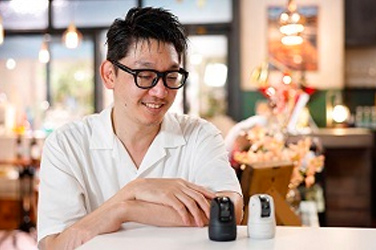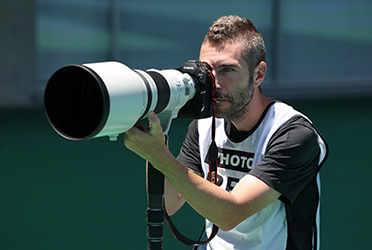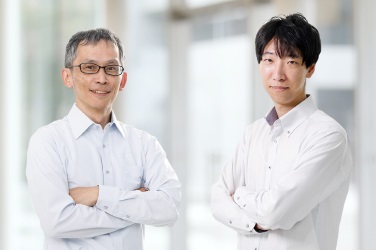Developers’ Story
A new concept camera designed for the video-centric era
- Capturing daily life on video
- Crystal clear sound
- Giving form to intuition
- Cross-generational collaboration
Young talent plays a key role as the team unites to create new video experiences.
In an era where shooting videos by smartphones and sharing them on social media has become ubiquitous, there has been a growing demand for "easier and higher-quality video shooting."
We spoke to a developer and a planner who both paved the way for new video experiences by grasping this evolving need quickly and spearheading the development of the video-centric "PowerShot V series."
Capturing daily life on video
A "new" concept born with the PowerShot V10
What was the inspiration behind planning a camera with enhanced video capabilities?
Ichimura:
Smartphones have become the dominant tool for video shooting, and sharing daily life by video has become deeply ingrained, especially among younger generations. In my own life, what used to be making videos of special occasions has, before I knew it, transformed into an everyday communication tool. The planning for the PowerShot V series (hereafter, V series) arose from the desire for people to "enjoy higher-quality videos more casually." The V series is a camera series with enhanced video capabilities, which emerged as a response to the growing demand for video shooting. Although video-specific cameras had already existed, they presented problems like "standing out when shooting in public" and "the inconvenience of carrying a tripod."

Imaging Business Operations
Nanaka Ichimura
Joined the company in 2023. After completing production training at the Utsunomiya Plant and sales training in Tokyo, assigned to the Imaging Business Operations. Involved in the planning and sales promotion of compact digital cameras.
* Affiliation is as of the time of the interview.
Ichimura:
To clearly deliver our vision to the entire team, we collaborated with our in-house design department from the project’s early stages to create a full-fledged concept book. We also interviewed video creators who are active on the front lines and incorporated their candid feedback into the design and functionality.
With these meticulous preparations, we launched the project for the PowerShot V10 (hereafter, V10) as the first in the V series, and continued with its development.

The concept book created for the project
What was the team's atmosphere like during the initial development phase?
Ichimura:
This was a highly challenging project since it was the first PowerShot series with enhanced video capabilities. However, as the functions and design began to take shape, the entire team became enveloped in an exhilarating sense of excitement. We cherish the idea of “First Canon” — hoping users will choose Canon for their very first camera. The development of V10 also began with this sentiment in mind.
Crystal clear sound
Unwavering commitment to sound quality and the pursuit of its pinnacle
Yoshida:
In video recording, sound is just as crucial as image quality. Poor audio can significantly diminish the appeal of the footage. Although external microphones can improve sound quality, they force compromise on compactness and convenience. V10 was designed as an all-in-one solution, with a relentless focus on the performance of its built-in microphone.

Imaging Business Operations
Senior Engineer, Takashi Yoshida
Joined the company in 2008. Involved in the mechanical design of compact digital cameras. Primarily handles designs using CAD to create 3D models and 2D drawings, while advancing product development in cooperation with other departments.
* Affiliation is as of the time of the interview.
What specific efforts were made to improve sound quality?
Yoshida:
When adopting the new vertical design for V10, we completely re-evaluated the component layout from the ground up. This allowed us to secure space for a high-quality, large-aperture microphone in a compact body, which was difficult to achieve with conventional designs.

The high-quality, large-aperture microphone built into the V10
At one point, we considered adding an accessory to the top of the camera to prevent wind noise from affecting the microphone. However, prioritizing compactness, we opted instead to incorporate a wind noise reduction filter and position the microphone upward. This design allows for clear recording of not only the subject's sound but also the cameraman's voice.
However, a camera with a high-performance microphone also has a risk of picking up internal operational noises. There was a concern even within the team that "a microphone that's too high-performance could actually become a problem." To solve this, we added a dedicated noise-cancelling microphone to V10. Developers from both the mechanical design team and the audio design team worked in unison, focusing relentlessly on minimizing operational sounds and recorded noise. By adjusting the balance of the microphones, we successfully achieved high-quality sound. This dedication to sound quality has since been carried over to PowerShot V1 (hereafter, V1), which was developed as part of the same V series.
Giving form to intuition
Pursuing usability through UI and heat management
Yoshida:
When developing V10, we particularly focused on creating an intuitive user interface (UI).
What were the key innovations in the UI design?
Yoshida:
What we prioritized most was intuitive operation for everyone. For the frequently used record start/stop button, in particular, we thoroughly examined its position, shape, and even tactile feel during operation. We repeatedly refined prototypes using a 3D printer until we achieved the ideal design.
Ichimura:
We adopted a symmetrical vertical design, allowing comfortable shooting with either hand, like a smartphone. We also simplified some aspects of the screen display and operation steps from the previous PowerShot series and incorporated features that make it intuitive and easy to use even for camera beginners. For instance, for adjusting brightness, we avoided using technical camera terms like "exposure compensation." Instead, we used a sun icon, just like on a smartphone.

An intuitive sun icon was adopted for the exposure compensation function.
Yoshida:
For the camera's lens, we consulted with the design team about the concept of a "large pupil" so it wouldn't stand out too much. We hope users will enjoy it almost like a companion that blends seamlessly into their daily lives.
A flagship model later appeared in the V series, right?
Ichimura:
Yes, the V series' flagship model, V1, was launched in April 2025. It expands upon V10's concept, which specialized in video recording, to become a model that allows users to compactly carry a single camera for both full-fledged video and still photography.
Yoshida:
The dedication to sound quality is just one aspect carried over from V10 to V1; there were many other innovations as well.
For example, heat management is one of the problems that often troubles developers during camera development. In compact digital cameras, the size of the body limits heat dissipation, making long video recordings difficult. For V1, we made the choice to incorporate a fan into the camera body for the first time among Canon compact digital cameras. Then, balancing heat dissipation with fan noise became a challenge. We had numerous discussions with the thermal design team about mechanisms that would efficiently dissipate heat while preventing fan noise from entering the microphone, even in a small camera. By automatically optimizing the fan's rotation speed, we enabled long video recordings without complex settings, which we believe met user needs.
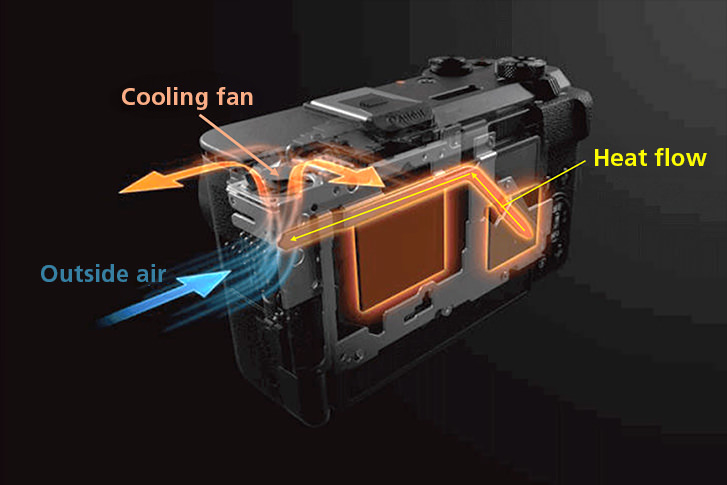
Heat generated inside the camera is directed to the left side of the body, where outside air is drawn in and expelled through a cooling fan.
Cross-generational collaboration
A team bringing together young talent and experienced engineers
Another characteristic point of the V series development was the active and flat communication that transcended positions and age.
Ichimura:
From the project’s initial stages, we collaborated closely with the development department, fostering an environment where even young team members could proactively share their opinions. When I joined the team, I was in my first year with the company, but was being assigned to a role with significant responsibilities. This allowed me to experience personal growth.
Yoshida:
What we take for granted isn't necessarily obvious to others. We were able to create an open environment where both younger and experienced engineers could exchange ideas on equal footing.
The fusion of younger members' flexible ideas and experts' extensive experience allowed the V series to achieve a higher level of product refinement.
This series, born from the unified efforts of the planning and development departments, truly reaffirms the strength of Canon's teamwork.
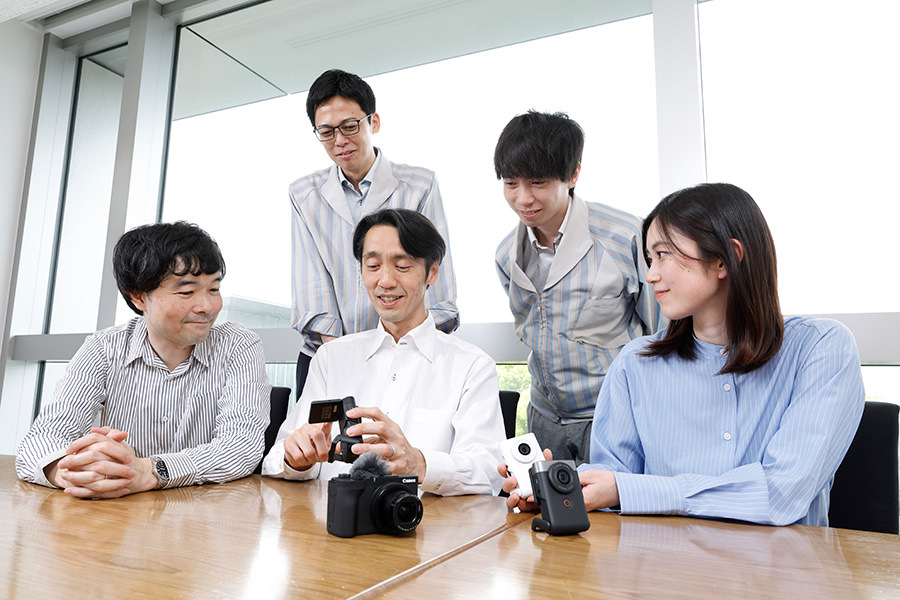
"Leveraging this experience, we want to continue creating exciting products in the future."


